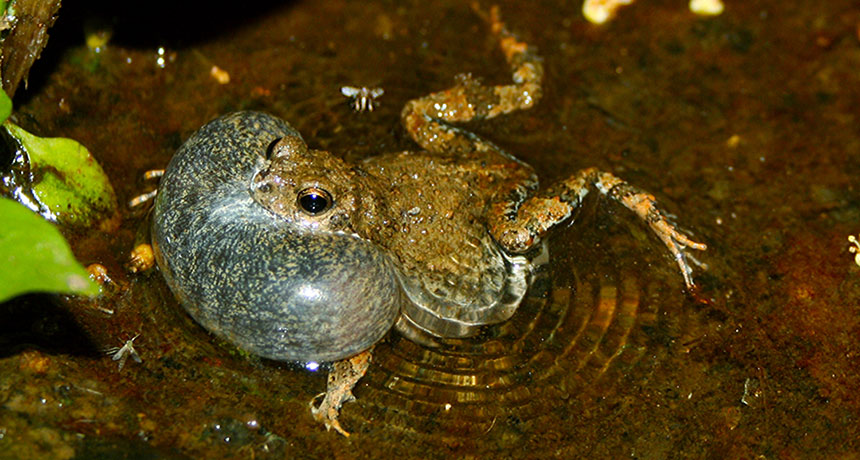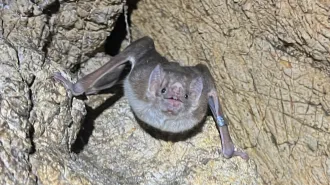Decoy switches frogs’ mating call preference
Third option alters choice of previous alternatives

CALLING CARD Male túngara frogs like this one attract their mates with a series of chirpy croaks. When picking between two calls, females tend to prefer a lower tone and more quickly repeated calls, but adding in a third suitor with an unattractive song may change a female’s preference between the two other males.
A.M. Lea
- More than 2 years ago
A trick that salesmen use to sell expensive cars may help average frogs snag mates.
Female túngara frogs often switch which of two mating calls they prefer upon hearing a third, unattractive mating call, researchers report in the Aug. 28 Science. This action resembles a human behavior known as the “decoy effect.”
“People are really interested in this because it’s such a common thing for people,” says study coauthor Amanda Lea, an evolutionary biologist at the University of Texas at Austin. The decoy effect is a well-known marketing trick, where one wholly unappealing option changes a customer’s preference between two others. For example, a customer might prefer a cheap, compact car over a spacious, expensive sedan. But if a salesman presents a third “decoy” option — a car about as large as the sedan but much more expensive — the customer often changes his mind and picks the sedan.
Just as a decoy car prompts a human buyer to change his or her mind, a decoy mating call can make a female túngara frog fickle. Lea and her Texas coauthor Michael Ryan, also of the Smithsonian Tropical Research Institute in Panama, presented 80 individual female frogs with three recorded mating calls. The calls varied in attractiveness of voice and speed of repeated calls. Females tend to prefer long, low croaks and quick repetitions, which might indicate a larger, more energetic male.

But when all three calls were played together in succession, many frogs switched their choice from the quick, attractive call to the intermediate option. “It’s sort of like they’re hedging,” says Lea. The placement of the speakers projecting the calls didn’t appear to influence the frogs’ flip-flopping preferences.
Giving the female frogs an additional option probably makes their decision harder, says evolutionary biologist Kimberly Hunter of Salisbury University in Maryland. The same is true for humans, she says. “If you’re a female and you go to a bar, there are a lot of males there. We have a hard time. So do the frogs.”
In a complex mating situation, the best available male doesn’t always win the females, says evolutionary biologist H. Carl Gerhardt of the University of Missouri in Columbia. Still, the female frogs’ flip-flopping was unexpected, he says. “The interesting and surprising thing is you actually get this reversal of preference.”
The study doesn’t reveal what’s driving this behavior, Gerhardt says. Hunter notes that the frogs are probably not assessing the quality of each call so much as responding to sensory stimulation.
Lea says future studies may explore what causes the switch in preference, as well as the evolutionary impact of choosing a less attractive — and possibly genetically inferior — mate. “We’re still trying to figure out exactly how it’s working,” she says.
But Hunter says the study provides a great starting point for asking more complicated questions. Using context from theories of human decision making and perception, she says, may greatly advance evolutionary biology.
|
PICK ME Male túngara frogs sing in a chorus to attract their mates. Females usually prefer lower, longer calls. A.M. Lea |







